|
Fun with Plastics
by Bob Brooke
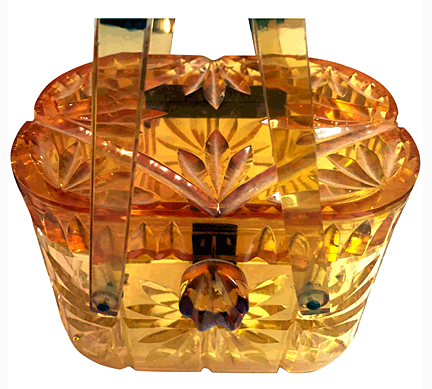 Plastics
has been around since just after the end of the Civil War, believe it or
not. They're so much a part of life today that most people canít
even imagine them existing during the Victorian Age. For the first time,
man was able to replicate materials found in nature, such as ivory and
tortoiseshell. Plastics
has been around since just after the end of the Civil War, believe it or
not. They're so much a part of life today that most people canít
even imagine them existing during the Victorian Age. For the first time,
man was able to replicate materials found in nature, such as ivory and
tortoiseshell.
The most common plastics are either thermoplastic or thermoset.
Essentially, a thermoplastic substance can he molded into shape by heat
and pressure, and once cooled to room temperature, it will harden and
retain its shape until exposure to heat makes it pliable once again.
Some of the most valuable and collectible pieces, made from
thermoplastic, require careful preservation because they arenít
indestructible. They can chip, crack or break if handled improperly and
they often discolor with age.
Celluloid
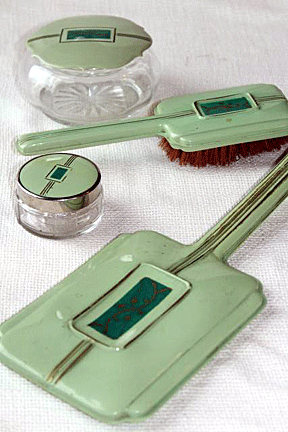 Nitrocellulose
celluloid was the first man-made thermoplastic material that gained
world-wide success. John W. Hyatt of Albany, New York, developed it in
1869, in an effort to win a cash prize for creating a substitute
material for ivory in billiard balls. Celluloid's greatest virtue was
its ability to be molded into articles that imitated the expensive and
scarce substances found in nature, such as coral and amber. Nitrocellulose
celluloid was the first man-made thermoplastic material that gained
world-wide success. John W. Hyatt of Albany, New York, developed it in
1869, in an effort to win a cash prize for creating a substitute
material for ivory in billiard balls. Celluloid's greatest virtue was
its ability to be molded into articles that imitated the expensive and
scarce substances found in nature, such as coral and amber.
By the turn of the 20th century, celluloid had made its appearance in
nearly every American home. It could be found in washable cuffs and
collars, dresser sets, jewelry, fancy hair combs, decorative boxes and
albums, advertising premiums, and even in the production of toys and
movie film, even though it was dangerously inflammable.
Bakelite
Molded Phenolic Resin, or Bakelite as itís commonly known, was the
world's first synthetic thermoset plastic, developed in Yonkers, New
York., between 1907 and 1909 by Belgian-born scientist Len Baekeland.
Initially, he was trying to create a varnish for bowling alleys by
combining phenol and formaldehyde, but instead he ended up with a
translucent amber resin that permanently set into a solid. The inventor
devised a fabricating technique that involved grinding the hardened
resin and combining it with dense fillers like slate dust or asbestos,
then compression molding the substance.
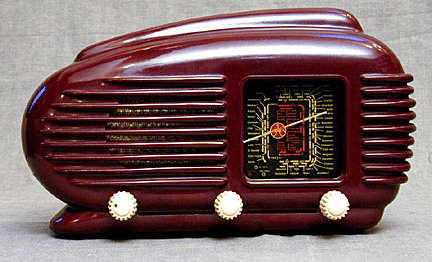
 Manufacturers
called it Bakelite and fabricated the material into a wide variety of
articles that required heat resistance and durability. Westinghouse was
the first to use Bakelite in its electrical components and shortly there
after others began producing car distributors, knobs and dials of the
unique substance. Other practical applications soon followed, and by the
late 1920s. radio and clock case manufacturers were using the strong,
dark plastic to mold them. Manufacturers
called it Bakelite and fabricated the material into a wide variety of
articles that required heat resistance and durability. Westinghouse was
the first to use Bakelite in its electrical components and shortly there
after others began producing car distributors, knobs and dials of the
unique substance. Other practical applications soon followed, and by the
late 1920s. radio and clock case manufacturers were using the strong,
dark plastic to mold them.
Early Bakelite objects were generally very dark because makers needed to
add dense filters to each batch. The most common colors were black,
brown, maroon, dark green, and butterscotch. In 1927, Bakelite
Corporationís patents expired and other manufacturers like Durez and
American Phenolics began production of compression molded thermosets.
But Bakelite also found its way into flatware handles and pieces of Art
Deco jewelry.
Beetle
 In
1924, a group of scientists from British Cyanide began to experiment
with thiourea formaldehyde and after several years developed a thermoset
material they called Beetle. The production technique involved
saturating cellulose fiber with a chemical solution, then grinding it
into molding powder. In 1928, they introduced their new plastic, which
they hailed as "the great white hope," because it was just as strong as
Bakelite but could be produced in pure white, as well as a rainbow of
colors. The Beall Shop was opened in London for the express purpose of
selling plastic goods made exclusively of this material. In
1924, a group of scientists from British Cyanide began to experiment
with thiourea formaldehyde and after several years developed a thermoset
material they called Beetle. The production technique involved
saturating cellulose fiber with a chemical solution, then grinding it
into molding powder. In 1928, they introduced their new plastic, which
they hailed as "the great white hope," because it was just as strong as
Bakelite but could be produced in pure white, as well as a rainbow of
colors. The Beall Shop was opened in London for the express purpose of
selling plastic goods made exclusively of this material.
The following year, 1929, American Cyanamid Company purchased patent
rights and began to manufacture Beetleware. Others soon joined the
bandwagon with names like Bandalasta. Linga Longa and Plaskon. Most of
the items fabricated were picnic sets, cups and howls, clock and radio
cases. But consumers soon discovered that the "Great White Hope" wasnít
as durable as it was once thought to be since the cellulose used in the
molding powder had a tendency to absorb moisture which resulted in
cracking and chipping.
Catalin
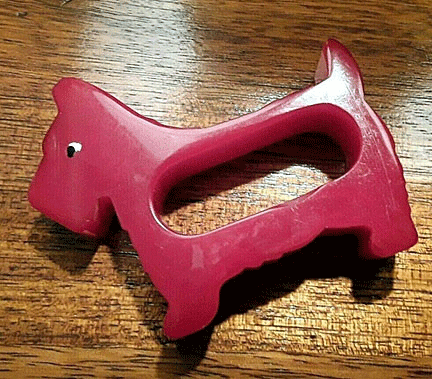 In
1927 after Bakelite's patents had expired, the America Catalia
Corporation was founded. This aggressive company manufactured a purified
form of phenolic resin that did away with the dense fillers so essential
to the molding of Bakelite. Their production methods also offered a
variety of translucent, opaque, mottled and variegated decorative
effects. In
1927 after Bakelite's patents had expired, the America Catalia
Corporation was founded. This aggressive company manufactured a purified
form of phenolic resin that did away with the dense fillers so essential
to the molding of Bakelite. Their production methods also offered a
variety of translucent, opaque, mottled and variegated decorative
effects.
The success of Catalin prompted other plastics manufacturers to venture
into the area of cast phenolics. Bakelite Corporation recognized its
competition and began to fabricate cast phenolics as did Fiberloid of
Springfield, Massachusetts., and the Marblette Corporation of Long
Island City. New York . Each company made a fair amount of buttons,
jewelry, toy parts, gaming pieces, umbrella handles, and trinket boxes,
but the biggest money maker was in radio cabinets, of which Catalin had
become the leader.
Acrylic
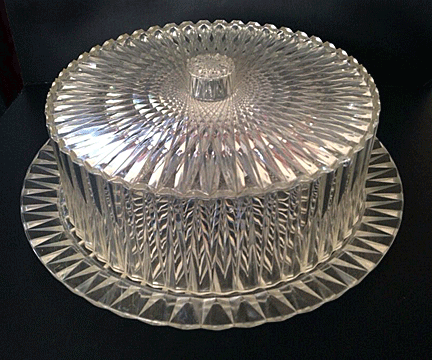 Commonly
called Plexiglas or Lucite, acrylic is a synthetic thermoplastic resin
developed in 1931 by Rohm and Haas in Germany. It resists shattering and
is crystal clear. Its first successful application was in the
manufacture of airplane cockpit shields under the trade name Perspex.
Manufacturers recycled scrap acrylic into dentures beginning around
1935. In 1936, Dupont introduced its brand of acrylic under the trade
name Lucite. The beauty and durability of translucent acrylic resin made
it a fine choice for molding vanity wares, jewelry, household
accessories, small novelty items and even postwar Commonly
called Plexiglas or Lucite, acrylic is a synthetic thermoplastic resin
developed in 1931 by Rohm and Haas in Germany. It resists shattering and
is crystal clear. Its first successful application was in the
manufacture of airplane cockpit shields under the trade name Perspex.
Manufacturers recycled scrap acrylic into dentures beginning around
1935. In 1936, Dupont introduced its brand of acrylic under the trade
name Lucite. The beauty and durability of translucent acrylic resin made
it a fine choice for molding vanity wares, jewelry, household
accessories, small novelty items and even postwar
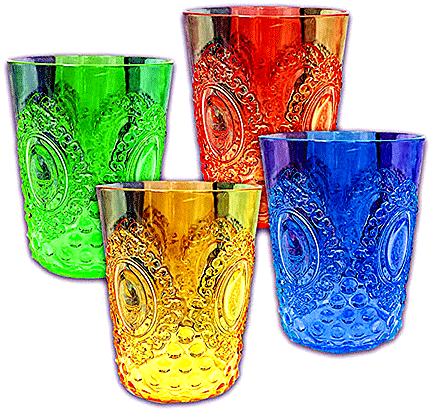 mid-century
modern furniture. mid-century
modern furniture.
Acrylic production boomed after World War II when designers began to
recognize its durability. Makers fabricated it into stylish compacts,
whimsical jewelry, and trendy purses. Elegant Lucite vanity sets
replaced old-fashioned celluloid on ladiesí dressing tables, and novelty
items began to appear in kitchens. One of the most recognizable of these
are the watermelon tumblers from H.J. Stotter. And vintage fashion
accessories are at the forefront of acrylic collectibles.
Modem poly plastics
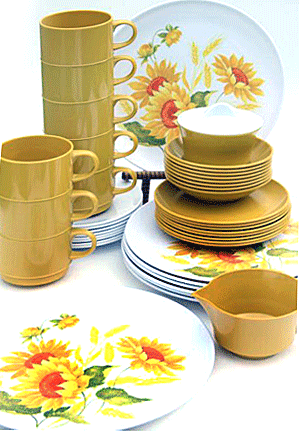 During
the years between World War I and World War 11, technology advanced at
an incredible rate. The invention of rayon, polyester and nylon
literally changed the way mankind looked at fashion. Viscous nylon,
commonly known as vinyl, found its way into the upholstery realm as well
as in toy manufacture. Polyethylene made its debut as Tupperware and
became as common in the kitchen as designer Russel Wright's colorful
Melmac dinnerware. By 1950 plastics had infiltrated nearly every area of
American life. During
the years between World War I and World War 11, technology advanced at
an incredible rate. The invention of rayon, polyester and nylon
literally changed the way mankind looked at fashion. Viscous nylon,
commonly known as vinyl, found its way into the upholstery realm as well
as in toy manufacture. Polyethylene made its debut as Tupperware and
became as common in the kitchen as designer Russel Wright's colorful
Melmac dinnerware. By 1950 plastics had infiltrated nearly every area of
American life.
Today baby boomers of the postwar era are reclaiming their childhood
memories by collecting all manner of plastic items made during the 1950s
through the 1970s. From hard vinyl Barbie and GI Joe dolls to
polystyrene Plasticville model railroad buildings, Aurora and Revel
model kits and Renwal dollhouse furniture, Bolero Thermoware, Stotter
vinyl placemats, and Rubbermaid products, to name a few. Some plastic
collectibles are commanding phenomenal selling prices. Fortunately for
beginning collectors, there were hundreds of thousands of plastic
novelties and toys produced during this time.
< Back
to Collectibles Archives
Next Article > |
